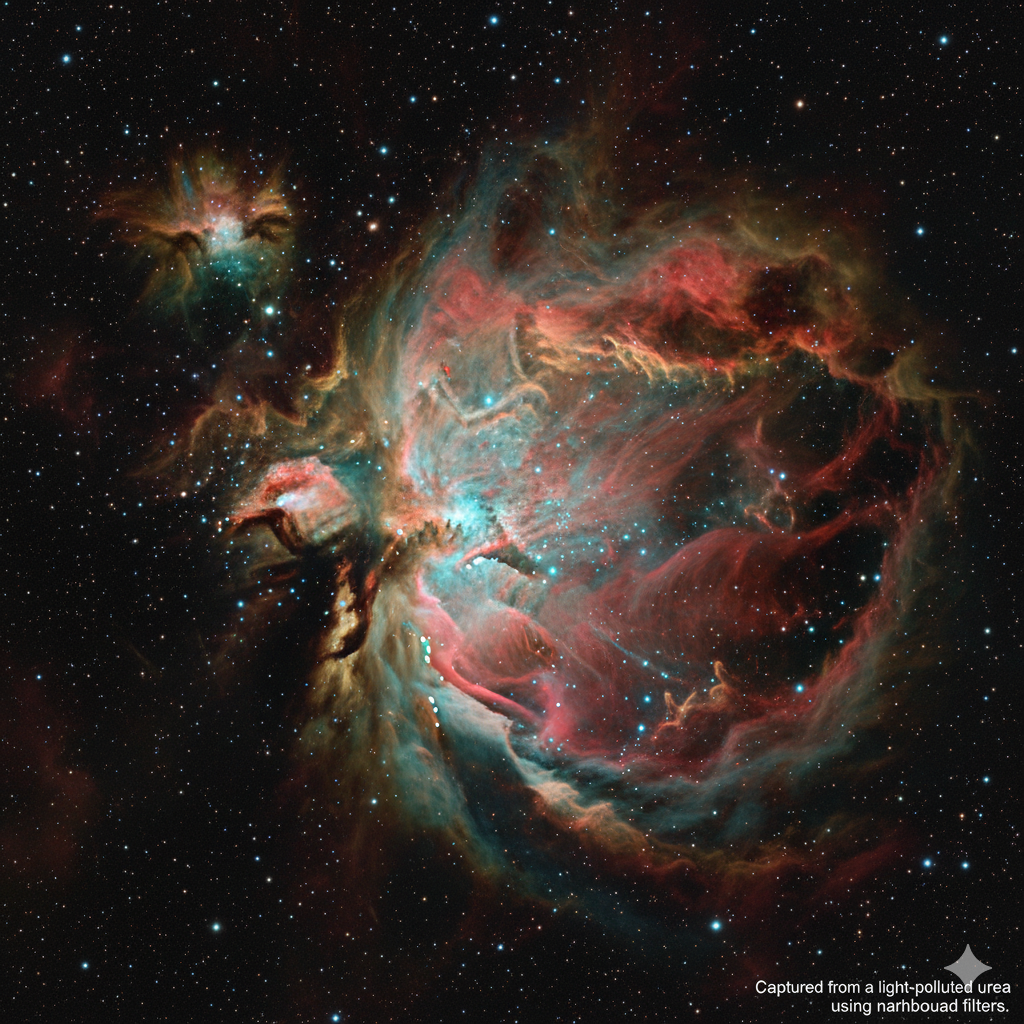
How Narrowband Filters Help in Astroimaging Under Urban Skies
Share
How Narrowband Filters Help in Astroimaging Under Urban Skies
Introduction: The Challenge of City Lights
Urban astrophotography is one of the greatest challenges for enthusiasts and professionals alike. Bright city lights wash out the faint glow of nebulae and galaxies, making deep-sky imaging nearly impossible without help. This is where narrowband filters change the game—allowing astrophotographers to bypass light pollution and capture incredible detail, even from a backyard surrounded by streetlights.
Chapter 1: Battling Light Pollution
Light pollution comes from artificial sources like street lamps, billboards, and buildings, flooding the sky with unwanted brightness. Long exposures taken in these conditions suffer from poor contrast and overwhelming background glow, hiding faint nebulae completely.
The Spectrum of Urban Light
Most city lighting emits in broad wavelengths, overlapping with the spectrum our cameras capture. The result is a noisy, washed-out image where your target object becomes invisible.
The Signal-to-Noise Problem
In astrophotography, the goal is to maximize the signal-to-noise ratio (SNR). Light pollution adds so much noise that faint nebulae signals are buried. Without filtration, the data you want can’t stand out against the overwhelming glow.
Chapter 2: The Science Behind Narrowband Filters
Many nebulae emit light at specific, narrow wavelengths. Narrowband filters exploit this by isolating only those wavelengths while blocking almost everything else—including most urban light pollution.
Common Narrowband Filters
- Hα (Hydrogen-Alpha, 656.3 nm): Captures the dominant glow of emission nebulae.
- OIII (Oxygen-III, 496 & 501 nm): Highlights oxygen emissions, common in planetary and emission nebulae.
- SII (Sulfur-II, 672 nm): Adds additional structure and color, often used with Hα and OIII in false-color imaging.

Blocking the Glow
By rejecting all but a few nanometers of light, narrowband filters allow long exposures without sky glow overwhelming the target. This dramatically increases contrast, clarity, and depth in your astrophotos.
Chapter 3: Practical Applications
Narrowband imaging requires patience but rewards astrophotographers with stunning detail. Instead of a single broadband exposure, you capture separate data for each filter and combine them later.
The SHO Palette
The famous SII–Hα–OIII (SHO) palette, pioneered by the Hubble Space Telescope, assigns each filter to red, green, or blue. The result is a breathtaking false-color image that reveals intricate nebula structures hidden from the naked eye.
Longer Exposures, Cleaner Data
Because filters block most of the light, exposures must be longer—often 5–10 minutes per frame. This boosts SNR, capturing delicate nebula features invisible in shorter exposures.

When Filters Work Best
Narrowband filters excel with emission and planetary nebulae. They are less effective for galaxies and star clusters, which emit across the full spectrum and require broadband imaging.
Chapter 4: Getting Started with Narrowband Imaging
Essential Equipment
- Telescope & Mount: A stable equatorial mount and quality optics are crucial.
- Camera: Monochrome cameras are best, though color cameras can work with dual/tri-band filters.
- Filter Wheel: Simplifies switching between filters without disturbing your setup.
- Filters: Choose high-quality narrowband filters with 3–7 nm bandpasses for maximum performance.

Workflow
- Polar align and focus your telescope.
- Capture multiple long exposures through each filter.
- Stack and calibrate images to reduce noise.
- Combine in software (PixInsight, Photoshop) to build a final color image.
Conclusion: Turning City Skies into Opportunities
For urban astrophotographers, narrowband filters are transformative. They unlock the ability to capture rich nebula details from even the brightest skies. With patience, the right tools, and careful processing, the wonders of deep space become accessible—no matter where you live.

FAQs
Q1: Can I use narrowband filters with a DSLR?
A: Yes, but performance is limited. Monochrome cameras are far more efficient for narrowband work.
Q2: Do narrowband filters help with galaxies?
A: No. Galaxies are broadband targets, so filters won’t isolate their light effectively.
Q3: Are dual/tri-band filters a good compromise?
A: Yes, especially for color cameras, as they capture multiple emission lines in a single exposure.
Q4: How important is guiding?
A: Critical. Since exposures are long, guiding ensures pinpoint stars and usable stacked images.
